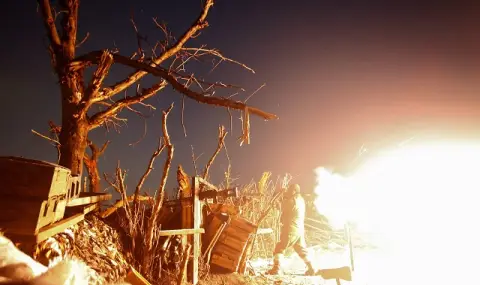Russian forces have by March 8 captured Novaya Sorochyna (northwest of Sudzha), Malaya Loknya (just south of Novaya Sorochyna) and Lebedevka (south of Malaya Loknya), as well as the fields between the settlements located in the Kursk region.
This is shown by geolocated footage and claimed by Russian bloggers, quoted by the Institute for the Study of War (ISW).
Russian forces have advanced into Sudzha itself with the support of North Korean forces. Russian bloggers claim that Russian forces have entered the industrial zone in northeastern Sudzha and are maintaining positions in the city along the eastern bank of the Sudzha River.
One Russian blogger claims that some areas of the industrial zone are a contested "gray zone".
Another Russian blogger claims that Russian forces are attempting to enter central Sudzha and have crossed to the western bank of the Sudzha River at least in one place in the city.
It is worth noting the temporal correlation between the suspension of US intelligence sharing with Ukraine and the beginning of the Russian collapse of the Ukrainian Kursk salient. Russia has been trying to push Ukrainian forces out of the salient in the Kursk region through slow, painful advances since the beginning of the invasion in August 2024. Russia later deployed approximately 12,000 North Korean military personnel in October 2024 to help repel the invasion, but Russian forces continued to make only incremental gains.
The Trump administration halted U.S. intelligence sharing with Ukraine on March 5, although there continue to be conflicting reports about the details of the U.S. suspension. Russian forces stepped up offensive operations to push Ukrainian forces out of the Kursk region on March 6 and 7.
A source connected to Ukrainian military intelligence reportedly began reporting a faster Russian advance into the Kursk region on March 5.
A Ukrainian government source stated in a March 8 Time article that the suspension of U.S. intelligence sharing had the greatest impact on Ukrainian operations in the Kursk region.
The Russian military has not yet prioritized efforts to push Ukrainian forces out of the Kursk region over further advances in eastern Ukraine, despite concentrating a sufficient force grouping to do so by the end of 2024.
The direct link between the suspension of U.S. intelligence sharing and the beginning of the collapse of Ukraine's Kursk salient The exact scope of the freeze on U.S. military aid and intelligence sharing is unclear, although Kremlin officials have recently announced their intention to take advantage of the freeze on U.S. military aid and intelligence sharing to "inflict maximum damage" on Ukrainian forces "on the ground" in the limited time frame before a possible future resumption of U.S. intelligence sharing and military aid to Ukraine.
Reports of the freeze on U.S. military aid to Ukraine continue to suggest that it will likely affect Ukraine's ability to defend itself against Russia. Forbes reported on March 7 that the Trump administration had halted U.S. support for Ukrainian F-16 fighter jets equipped with radar jammers. The Wall Street Journal (WSJ) reported on March 8 that a source familiar with the matter said that Ukraine is currently capable of firing one artillery shell for every three that Russian forces fire, even with Ukraine's current supplies of U.S. shells. The halt in U.S. support would likely hamper Ukraine's ability to continue using the aircraft to defend against Russian strikes in Ukraine's rear. Ukrainian officials said in December 2024 that Ukrainian forces had managed to gain an artillery advantage of 1.5 to one or three to one in some areas of the front, and Russia's current artillery advantage over Ukraine is likely to continue to grow as Ukraine's stockpiles of U.S. ammunition dwindle after the military aid was cut. from the United States.
Ukraine's European allies continue to provide material and financial assistance to Ukraine. French Defense Minister Sebastien Lecornu announced on March 8 that France would use the interest accrued on frozen Russian assets to provide Ukraine with military aid worth 195 million euros.
Lecornu noted that the funds will facilitate France's delivery of 155mm artillery shells and AASM Hammer missiles to Ukraine, which are compatible with France's Mirage 2000 fighter jets supplied by Ukraine. Lecornu added that France is accelerating the transfer of unspecified older armored fighting vehicles to Ukraine. Norway's parliament agreed on March 6 to increase military aid to Ukraine to a total of 85 billion Norwegian kroner (approximately $7.8 billion) in 2025 - an increase from Norway's November 2024 pledge. to allocate approximately 35 billion Norwegian kroner (approximately $3.2 billion).
Ukraine's European partners may be able to independently provide commercially available satellite imagery to Ukraine amid the suspension of Ukraine's access to US portals with such imagery.
The Financial Times reported on March 8 that Anders Linder, head of international operations at commercial satellite imagery provider Maxar Technologies, said that any of Maxar's commercial customers - including US allies and partners - could use the data they purchase from Maxar "as they see fit", including by "sharing it with their allies, such as Ukraine".
Russia continues to demonstrate its deepening ties with US adversaries despite ongoing bilateral talks between the United States and Russia. Russia, China and Iran announced on March 9 the opening of their annual trilateral naval exercises "Maritime Security Belt - 2025" in the port of Chabahar, Iran.
Iranian state media Mehr News Agency said the exercises would begin on March 11.
Russia, China and Iran have held the exercises in 2019, 2022, 2023 and 2024, and the Russian Defense Ministry said the aim of the exercises was to "ensure maritime security, combat piracy and terrorism at sea, and protect maritime communications."
China's Defense Ministry said the exercises were aimed at "deepening mutual trust and pragmatic cooperation between the armed forces of the three countries."
